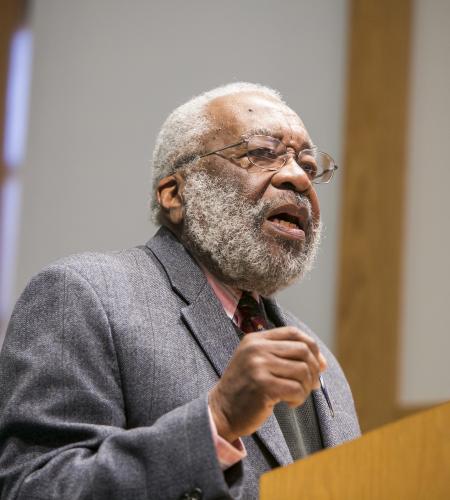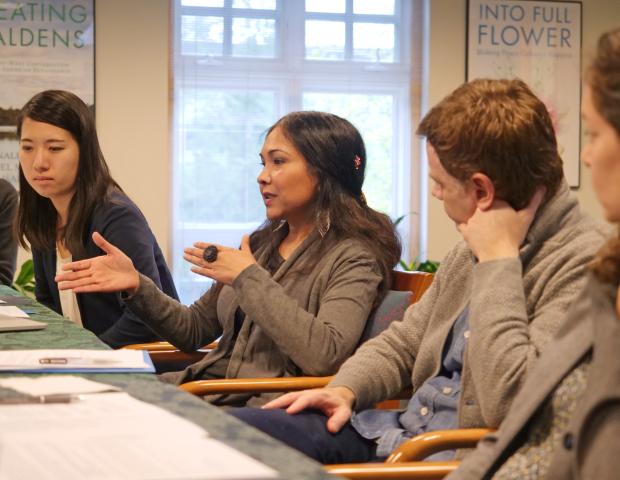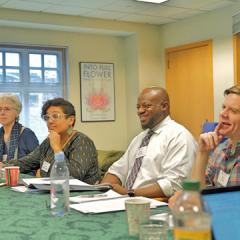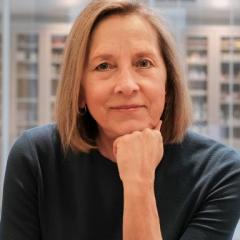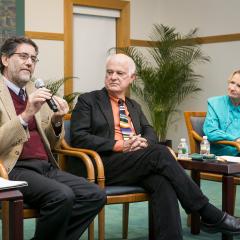Over the last several years it has become apparent that nearly every topic or project the Ikeda Center turns its attention to requires a close consideration of the place of dignity within it. In other words, while dignity is a worthy topic in and of itself, digging into the particular meaning of dignity for scholars working in the various fields that comprise the movement toward peace and justice can enrich everyone’s appreciation for both the complexity of dignity in human affairs. In November of 2018 the Center convened its first gathering of established and emerging scholars to address the topic of “Reinvigorating Dignity in Displacement.” In May of 2019, the Center convened a follow-up seminar, reported on here by Mitch Bogen.
Dignity Re-examined: A Dialogue Across Discourse Communities
Returning from the first seminar were two scholars from UMass Boston: Zeena Zakharia, whose work has examined education in war-affected contexts; and Patricia Kreuger-Henney, who conducts participatory action research with young people focusing on social inequalities they face educationally. Also returning was Jason Goulah, executive advisor to the Ikeda Center and a professor of bilingual-bicultural education and Director of the Institute for Daisaku Ikeda Studies in Education at DePaul University in Chicago. New to the dialogue was Elora Chowdhury, also of UMass Boston, whose interests encompass transnational feminisms, critical development studies, and gender violence and human rights advocacy. Emerging scholars from their respective doctoral programs included Chris Hall and Nina Kunimoto from UMass Boston and Nozomi Inukai and Ritsuko Rita from DePaul.
The seminar opened with welcoming remarks from Ikeda Center executive director Virginia Benson. She framed things in terms of the centrality of dignity to building “cultures of peace,” making two particular points. First, she noted how, in her interactions with the Ikeda Center, the groundbreaking peace scholar and activist Elise Boulding had always celebrated the peace movement’s evolution from being simply “against war” to being proactively focused on the building of creatively complex cultures of peace. And, referencing the first seminar, Benson said that dignity-based cultures of peace require us to be in “right relation with everyone and all life,” and that one basis for this relates in some way to what Dr. Zakharia called “the divine spark” within all life.
Kevin Maher, the Center’s Program Director, noted that since last November’s seminar, matters of dignity, or rather “the lack of dignity,” only seem more and more pressing — not only in politics, which is unavoidably apparent, but in “educational and social spheres” as well. Reflecting on the thinking that has informed the Center’s dignity-related work over the last couple of years, Maher cited two “touchstones.” The first is Daisaku Ikeda’s idea that “the inherent dignity of life does not manifest in isolation. Rather, it is through our active engagement with others that their unique and irreplaceable nature becomes evident.” The second was from Betty Reardon: “We must come to an awareness that as human beings we are endowed with dignity. At its essence this means we are worthy of life, we are worthy of respect, and we are responsible to give respect and affirm life.” Further, “when we say we are about peacebuilding, we should be about the realization and actualization of human dignity.”
Beginning with a consideration of how dignity is understood in various contexts relating to peace and human rights, the discussion evolved organically to explore the relationship of happiness and dignity, whether there are limits to acknowledging dignity, how best to understand the suffering of others, and promising ways to make human connection across differences.
1. What is the most accurate and productive way to talk about and promote dignity?
The dialogue opened with participants discussing whether it is critical to make distinctions about how dignity is perceived in the dignity, human rights, and social justice “discourse communities.” Zakharia said that the key isn’t so much the making of distinctions as it is to “understand the [pathways] to dignity as multiple, and that there are spaces for anyone to talk about it whichever way they want, whether they pursue environmental justice, or social justice, or indigenous studies, or something else.” In other words, the real goal is to discourage anyone or any field from saying they have a better claim than others to a concept such as dignity or social justice, and so on.
Krueger-Henney concurred that it is important to think “plurally” about dignity, adding that maybe the best approach is not to start with definitions but to engage in “envisioning” goals and projects, and then to work backwards to determine the role of dignity in it. In other words, abstract discussions defining dignity may prove unproductive. As a “real example” she cited the AERA (American Educational Research Association) annual meeting. AERA brings together many thousands of educators each year for panels, meetings, and discussions, many of which deal with “injustices in education,” she said. And, “guaranteed, if you would drop the message into the air of AERA, ‘Do you believe in the importance of dignity?’, all these folks would say, ‘Absolutely!’” Nevertheless, she said, the problems in schooling relating to dignity have scarcely been addressed.
Dr. Chowdhury entered the conversation here with reflections on the limitations of the human rights perspective for discussing and promoting human dignity. These limitations have to do with a few factors. There is the fact that the Enlightenment values that led the conception of human rights were hardly inclusive of all people. At the time of their codification in 1948, the sanctioning states and institutions were not necessarily committed to the expansion of justice. And, finally, there is the reality of unequal enforcement, based on power dynamics rather than ethics. In other words, said Chowdhury, we see “selective understanding and selective enforcement.” Krueger-Henney added that the aftermath of WWII, the point at which the Declaration of Human Rights was approved, represents something of a missed opportunity to re-envision the world along more just lines. Chowdhury concurred that, the idealism of the UDHR notwithstanding, postwar agreements tended to consolidate various patriarchal, neo-colonial, and imperialist structures not conducive to widespread dignity.
Zakharia responded here, suggesting that, okay, let’s just “take that structure away” and look at it differently. We can see that “subjugated people all over the world have been working toward something that we might call dignity here, with or without the UDHR.” There are “multiple streams” working toward this, working for a better life and “respectful relationships,” with indigenous movements providing a good example from outside of state structures. Chowdhury said that many groups do work for rights and dignity outside the state, but their “legitimacy” is often questioned or hampered by the powerful.
2. What does happiness have to do with dignity?
Musing on dignity as considered outside state structures, Jason Goulah asked, rhetorically, “If a person is alone on an island, do they have dignity?” In his view, dignity is mostly understood relationally. “There’s a kind of innate quality to human life that emerges fully in the social dynamics of living with others” that gives rise to dignity. Here, he placed the concept in the context of Tsunesaburo Makiguchi’s conception of value creation, which refers to actions that meld benefit to the individual self with contributions to the social good, while also having an “aesthetic dimension.” When you achieve this, he said, the result is a “genuine, almost existential happiness.” Though ‘happiness’ can have superficial or Pollyanna connotations, said Goulah, it is still the best word to explain what we are getting at in discussions of dignity. “Dignity,” therefore, “is the capacity to have happiness.”
Nozomi Inukai added some more context, citing a book called Refugee Change Makers: From Displaced to Indispensible. Inspired in part by Daisaku Ikeda’s peace proposals, it tells thirteen stories of refugees currently living in Amsterdam. The stories showed that these refugees could regain a sense of dignity in two related ways, said Inukai. They begin to thrive when they find a sense of purpose either in their homeland or new community, and also when they find ways to contribute either to their refugee community or the larger community they find themselves in. Many of the refugees indicated increased fulfillment and happiness, a good definition of value creation.
Here, Ritsuko Rita referenced Karl Jasper’s concept of the “boundary situation,”* a notion Daisaku Ikeda cited in his 2019 peace proposal and which served as part of the “touchstone” background reading material for the seminar. She quoted this from Ikeda: “When we recognize our own boundary situation and resolve to overcome it, the narrowness of our individual circumstances, which cannot be supplanted for anyone else’s, is transformed into the depth with which we live out our original selves.” She said she was struck by this concept of depth and how it results from each of us dealing with our hardships and obstacles in our own ways. This speaks both to plurality and value creation, in terms of defining our contributions to others.
Chris Hall works in special education, a field in which, he said, much discussion is devoted to the question of what is “individual” versus what is “generalizable.” Thus, “I wonder if dignity is something that can be generalized or is it in the individual?” His thought was that both happiness and depth are generalizable as principles, but that individuals experience each uniquely. As a “concrete example”: Some people are more comfortable swimming in deeper waters than others. This kind of comfort is an individual feeling, he said.
Bringing in some skepticism about the usefulness of happiness as a benchmark, Elora Chowdhury asked Goulah to talk a bit more about what he means by it. Referencing the work of feminist philosopher Sarah Ahmed (whose blog Feminist Killjoy tackles such issues), she wondered if it makes sense for happiness to be presented as something we “are compelled to aspire to,” a “sort of neoliberal pressure,” something which can be measured in “happiness indexes.” So what is happiness? Is it self-contentment? A recognition of the self? Self-actualization?
It’s definitely not a neoliberal notion of, “Oh I have this and I have this so now I’m happy,” said Goulah. He placed the roots of the happiness concept in the value-creating pedagogy and philosophy of Makiguchi, which, fundamentally, “is a way of becoming socially self-actualized, not just individually self-actualized.” Further, it’s a way to “understand the full capacity of the depth of your life,” and from this you live true to yourself and your community, extending to the global level. The other key thing about value creation is the focus on meaning making. “What kind of meaning do we make from something?” An example: Consider nuclear fission, he said. You can generate power for the community or you can build a bomb to destroy life. When you find a way to serve yourself and humanity, while adding aesthetic beauty, then you are approaching “fundamental happiness,” almost “existential happiness.” Such happiness in no way suggests attachment to possessions, a behavior that, as Makiguchi put it, leaves you “at the whimsy of your environment.”
To illustrate different conceptions of happiness, Nozomi Inukai cited a recent sociology survey that collected definitions and images of happiness from both the United States and China. Among the US population, happiness was “very much associated with pleasure or joyful feeling.” The Chinese, on the other hand, talk about xingfu, a conception of happiness more “associated with meaningful life.” Given that Makiguchi was writing in Japanese, she said, his concept of happiness likely was also different than the US conception. Goulah wrapped up, saying that happiness might not always be the applicable term when we strive toward “celebrating the dignity of the human being.”
3. Does everyone deserve to be perceived and treated with dignity?
Krueger-Henney spoke up to “flip this a little bit,” and to be transparent about some of her own “boundaries.” Specifically, she asked: “Who deserves to be seen as a dignified human being?” In other words, the truth is that, for example, there are “current political leaders around the world” whose dignity she quite simply would not want “to fight for.” And then there are the people she encounters “who can’t go through the day without making one racist statement.” Calling this her own “inner political struggle,” she said it is also a “larger social, political struggle.”
But, wondered Goulah, does dignity demand something of us? Is there an imperative to extend dignity even when we don’t want to? Do we need to work through it? Krueger-Henney replied that her impulse frequently is to tell herself, “Hell, no, I don’t have to!” Still, she acknowledged that given the “hierarchized value system” that has pervaded mainstream human rights structures, with not everyone seen as deserving or meriting dignity in equal measure, her own hierarchized understanding could be “problematic.” Chowdhury alluded back to Goulah’s “island” question, saying that if dignity is inherently relational, then the historic inequality of “political social structures” makes the mutuality that dignity requires more than a little elusive.
Adding a perspective drawn from Daisaku Ikeda’s 2019 peace proposal, Virginia Benson shared the Buddhist parable of Angulimala, an infamous mass murderer whose life is transformed after an encounter with the Buddha. Chasing after Shakyamuni Buddha in order to add him to his victims, he yells, “Stop!” Shakyamuni replies, I have stopped, but it is you who must stop. Ikeda explains:
The perplexed Angulimāla then asks him why he is being asked to stop when he has already stopped moving. Shakyamuni explains that he was referring to Angulimāla’s acts of killing living things without mercy and the malice behind them. Deeply affected by Shakyamuni’s words, Angulimāla determines to eliminate the malice in his heart and cease his evildoing. Then and there, he throws down his weapons and asks to become Shakyamuni’s disciple. From that time on, Angulimāla deeply repents his past crimes and engages earnestly in Buddhist practice, seeking expiation.
Ultimately, said Benson, Angulimāla goes on to become a healer of the suffering of others, completing his redemption. The parable shows that, as Benson put it, “everyone, even the worst of us, has the potential through self-reflection” to begin to manifest their dignity and their positive potential. This story, said Benson, reminded her of other writings where Ikeda has referred to “the irreplaceable value of each life.”
In her view, Krueger-Henney felt that though the story does a good job of showing the heart of, for example, “the abolitionist movement,” it nevertheless is too big of a stretch for her to accept a method of “restoring humanity” like this if it depends on “exonerating crime.” Consider all the former dictators of the Global South that have been granted asylum by other countries while the people they abused receive no justice! Look at the de facto war criminals that rehabilitate their reputations by later leading various pro-social initiatives.
Also joining in the seminar was Center Program Manager Lillian I. She said that she has struggled to extend understanding or compassion to certain perceived opponents in today’s severely polarized political environment. In order to achieve some equanimity, she has leaned on a passage from a message Mr. Ikeda sent to the Center on the occasion of its 25th anniversary in 2013: “Whatever country we hail from or interests we represent, in the end we are all human. We are comrades together confronting the universal human experiences of birth, aging, sickness, and death. Our lives are like precious gems bearing within them an indomitable force for good. We were all born of mothers whose deepest desire is for peace.” Meditating on this has helped relieve some of her anger, Lillian said. And striving to recognize dignity in others along these lines has helped her make sense of the world in a way that revives her hope.
Ritsuko Rita followed by talking about the importance of seeing the others as human, just as you are human. She shared her experience working with a former refugee from Iraq on a paper focused on bringing refugee and non-refugee students together in the classroom. They employed concepts of dignity and empathy that reflected her collaborator’s conviction that we must come to understand that whatever happens to another person “can happen to you,” and that their problems aren’t just “somebody else’s problems,” they are yours too. Thinking along these lines, Nina Kunimoto shared a story from her experience leading a lesson on poverty and eviction with high school students. At one point a student said, “When I sabotage myself, I sabotage my partner.” This idea really made an impression on her. If the problem with human rights discourse is that it is too individualized, she wondered what it would mean “to move from the me or my group to the we in terms of not sabotaging support and solidarity.”
This portion of the dialogue concluded with some reflections from Zeena Zakharia. Commenting on questions about whether dignity is too tainted by its central place in modern Western human rights discourse, she reiterated that “because the concept arises in so many cultures, histories, political landscapes, religions, etc.,” there is clearly something being referred to “that isn’t bound by contemporary political or social structures.” She then reflected on “the irreplaceability of human life,” the Ikeda idea raised by Benson earlier. This idea, too, seems to appear in traditions across time. Yet there are many people that “for whatever reason are not able to connect with that.” Here’s the thing, she said: “When we treat others as if their lives are replaceable or diminish somehow their worth, we at the same time diminish our own.” Posing a hypothetical “challenge” to Patricia, she asked, what would you do if that war criminal “laid down bleeding in front of you”? “I’m not gonna say what I’m thinking!” said Patricia. But in “that act of walking away,” proposed Zeena, you “would get hurt.” Patricia acknowledged her point with a heartfelt “I hear you.”
4. What is the most conscious way to understand and honor the suffering of others?
Before moving to a discussion of empathy and lessons from black feminism, Elora Chowdhury made one observation about the previous discussion, which is that when it comes to dignity, the way it is recognized at the interpersonal level is clearly different, and perhaps more easily envisioned, than at the state or juridical level. As for the practice of empathy, many scholars, including black feminists, are seeking to “problematize” it, given the way “power relations” obtain even interpersonally. Citing the work of Saidya Hartmann on the complexity of “recuperating” slave narratives, she asked a number of questions. Is it possible to “tell a complete story of an abject situation?” And “who does the work of the telling?” “Is it truly a lens of empathy?” On this last point, she cautioned against the kind of pseudo-empathy that comes from a place of “self-centeredness” and reads more like “self-aggrandizement.” She is very much motivated by Hartmann’s call for us “to imagine a new way of seeing” outside of “the racial grid” that has slavery as its “foundational principle.”
She also shared two insights from her recent reading of Richard Wright’s Native Son.** In a key scene, the now-imprisoned Bigger Thomas, a young black man, has a “reckoning” with his lawyer, Max, a white Jewish Communist. As such, the lawyer claims an alliance or connection with Bigger that perhaps he hasn’t earned. Nevertheless, said Chowdhury, “he is able to draw out this dynamic where Bigger starts to see himself in a different light.” Bigger says that Max has asked him questions nobody ever has before, questions about his own life and whether it “has meaning” or whether it “does not.” Still, while this portrayal of the sharing of dignity at the interpersonal level is compelling, the novel also does “a brilliant job” of exposing the “shortcomings” of the “larger structure” that shaped Bigger and his experience. Goulah responded here, saying how this narrative reminded him of Bakhtin’s “notion of the surplus of seeing,” the idea that we can see things about others that they can’t, and thus through interactions with others we come to understand aspects of ourselves we might otherwise not have.
Krueger-Henney extended the discussion of black feminism and its relationship to the nurturing of dignity in difficult circumstances. In the course she teaches on these topics, Krueger-Henney always introduces the African symbol of the Sankofa bird, whose feet point forward, but whose head looks backwards. “The message of Sankofa is that you can only move forward by being familiar with your past,” she said. Cynthia Dillard is someone who speaks about remembering as re-membering, how we reassemble ourselves and complete each other through the remembering of histories. Another person who could “really inform” her further engagement with dignity work is the public health demographics scholar Arline Geronimus, who originated the concept of “weathering” to describe the “intergenerational trauma” experienced by populations exposed to injustice, especially African-American women. Quite literally, their bodies experience weathering, something recognized in physical systems as erosion by constant stress. However, said Krueger-Henney, black feminist dignity really “kicks in” when Black women stand up and say, “We’ve weathered enough!” Extrapolating, she said that she imagines that dignity is never fully stripped away, and if we look closely we might even see how these weathered bodies manifest “levels of dignity.”
Given the challenge of understanding the suffering of others, asked Benson of Chowdhury, are we better able to understand them on this kind of deep level when we recognize their dignity? For Hartmann, said Chowdhury, the issue has been that there has been a “hierarchy” of perceived suffering in which the “historical suffering of the Black population” has been downplayed because for too many people “the Black population has not been seen as fully human.” Related notions, said Chowdhury and Krueger-Henney, include that “certain feelings or sensations are not attributed to the Black body” and that they are “not capable of love,” even for their own children.
Inukai shared that she doesn’t quite know how to think about these matters of not being able to understand the suffering of others. She does try to draw on serious ordeals she has undergone, such as being detained for several hours while going through immigration with no explanation why, no way to communicate, and with all her identification stripped. She never did receive an explanation for why she was held. Then there was the time she lost her apartment to a fire. But she knows these are “limited” and that she can’t truly understand others, so ends up wondering, “What do we do?”
5. How do we make compassionate human connection?
The conclusion of the discussion looked at various responses to the question of what can be done, especially in finding ways to make true human connection. As Goulah put it, much of the current discourse is within the “post-modernist, post-structuralist” framework which holds that “you can’t possibly understand” others, which can inculcate a sense of helplessness about solving various injustices. Nina Kunimoto said this is one reason she ends her class on Race, Class, and Gender with the example of John Brown, the white man who famously took up arms in the cause of abolition, fearlessly showing solidarity with the enslaved population of the South. Elora Chowdhury mentioned Judith Butler’s notion that “human beings are tied through a common condition of vulnerability,” and that this provides a way to consider others’ pain (echoing the earlier Ikeda quote shared by Lillian I on how we all are “comrades” insofar as we face birth, aging, sickness, and death). But here’s how Chowdhury said she would actually reframe the issue. “Do we have to feel the pain of others in order to be moved to moral action and solidarity?” Do we even have to share that vulnerability to feel moral responsibility?
Ritsuko Rita talked about how there are different levels of understanding and connection. Referring to her experience getting to know her classmate who was a former refugee, she noted that just in talking with him she became more aware of what she didn’t know. For example, when he discussed having to teach himself English, she realized that the idea of having to learn a language without a teacher was completely outside her experience. Zakharia expanded on this, saying that it’s vital to be able to see dialogue as an opportunity to learn from others, to be “reflexive” about what we can and can’t know, and to become open to learning about our own “privileges.” Rita responded, highlighting another subtle aspect of dialogue, namely, that it is the intention to learn that she brings to a dialogue that has the biggest impact on how much she is transformed by the encounter.
Chris Hall placed the preceding conversation in the context of his work with special needs children, including those with autism. When “I think about my experience working with students that have experienced trauma and people in my personal life that have experienced trauma,” when asked about it they often won’t be able to “give you a date or tell you the time of day it was,” but they will be able to tell you “how the trauma made them feel.” They remember the sounds, smells, and bodily feeling of the trauma. There was something that was experienced, he said, “regardless of the level of the trauma” or one’s personal “interpretation” of it. In his view, the same dynamic holds for when one does not receive dignity or when dignity is taken away. As for the prospects for effective dialogue: though we don’t necessarily need to know, nor may we want to know, the full extent of another’s trauma, we can “empathize with the feeling of trauma.” From that point forward, he said, dialogues around dignity should be “co-constructive.”
He concluded with one more thing he identified as important to understand about dignity, which is that what might not appear to any one of us as a dignified state or activity may be dignified for another. “We need to tread lightly” when making “generalized” statements about what another experiences as dignified, something he said he has learned from working with autistic students. “I might be happy and fulfilled having this conversation with all of you,” he said, “or I may feel that way lining up toy cars in a row.”
Coda: Two Inspirations
As the dialogue was winding down, Kevin Maher shared a story from Bryan Stevenson’s book Just Mercy that has deeply informed his understanding of these matters of empathy, dignity, and dialogue. As a young law student, Stevenson was adrift and on the verge of dropping out when he took an internship with a law firm down south specializing in human rights law. Stevenson participated in their work with death row inmates. When he was assigned to visit an inmate to tell him that his execution would be delayed for a certain number of months, Stevenson’s whole direction in life changed. His visit began by “stumbling” through his report to the prisoner, who hadn’t seen anyone other than a guard or fellow inmate in over a year. But suddenly, “the guy is just so joyful to connect with another human being and to be talked to as a human being,” said Maher, “that he just starts singing. And Stevenson is so moved by this encounter that it totally transforms what he’s planning to do.” Today, Stevenson is one of the US’s most important advocates for the rights of prisoners, the abolition of the death penalty, and reform of our criminal justice system.
After Virginia Benson extended her appreciation to everyone for their “rich” contributions that “challenged our resignation to the situation of the world as it is,” Jason Goulah offered some closing thoughts. He drew from the work of curriculum studies scholar Bill Schubert, who encouraged educators to ask of themselves questions such as: What is worth knowing? What is worth doing? What is worth being? What is worth sharing? What is worth imagining? These kinds of questions, argued Schubert, are not “answerable” for all time, but rather must be continually asked. This, said Goulah, is the kind of vital inquiry into dignity we sought to engage in today, adding that “there is something beautiful in this coming together of people from different fields and different perspectives and different disciplines. I always learn a lot personally and I always feel more joyful.”
Notes
* In the 2019 peace proposal, Daisaku Ikeda describes Jaspers’ concept of the boundary situation like this: “He used the term ‘boundary situation’ (Ger. Grenzsituation) to describe the unavoidable realities that individuals confront. He pointed out that the only way to avoid a boundary situation in our in our present existence is to close our eyes to it, but that to do so would be to shut ourselves off from our inner potential.” (See Karl Jaspers, Socrates, Buddha, Confucius, Jesus: The Paradigmatic Individuals, 1962)
** Native Son is Richard Wright’s classic novel of 1940. It tells the volcanic story of the black youth Bigger Thomas, whose accidental killing of a white woman sends him on a violence-filled flight from the authorities. In the end, he is apprehended and sentenced to death. In Irving Howe’s words of 1963, Wright “brought out into the open, as no one ever had before, the hatred, fear, and violence that have crippled and may yet destroy our culture.”
